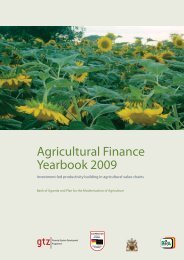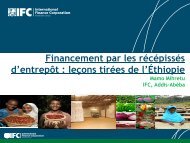Innovations in Rural and Agriculture Finance
Innovations in Rural and Agriculture Finance
Innovations in Rural and Agriculture Finance
You also want an ePaper? Increase the reach of your titles
YUMPU automatically turns print PDFs into web optimized ePapers that Google loves.
<strong>and</strong> medium enterprises (SMEs), <strong>in</strong> order to be effective tothese target groups. Political pressure has forced <strong>in</strong>stitutions <strong>in</strong>some countries to provide rural f<strong>in</strong>ancial services, but, with nocommitment, results are poor.• Sufficient scale <strong>and</strong> market share is essential for banks with arural orientation.• Client l<strong>in</strong>kage to corporate governance—for example, rural<strong>and</strong> urban client shareholders or client panels—can positively<strong>in</strong>fluence performance <strong>and</strong> safeguard the rural mission ofan <strong>in</strong>stitution.• Clear client segmentation l<strong>in</strong>ked to products <strong>and</strong> distributionchannels is essential to effectively deliver<strong>in</strong>g products <strong>in</strong> therural environment.• Direct product distribution channels—<strong>in</strong>clud<strong>in</strong>g mobile-phonebank<strong>in</strong>g, ATMs, <strong>and</strong> electronic po<strong>in</strong>t-of-sale devices—arebecom<strong>in</strong>g <strong>in</strong>creas<strong>in</strong>gly important for rural f<strong>in</strong>ance delivery. Amodern <strong>and</strong> up-to-date IT system is crucial to these services.• <strong>Rural</strong> banks <strong>in</strong> Africa need to focus on both sides of the balancesheet (that is, offer an appropriate mix of sav<strong>in</strong>gs <strong>and</strong> lend<strong>in</strong>gproducts). Due to a lack of well-operat<strong>in</strong>g markets, they needto be largely self-f<strong>in</strong>anc<strong>in</strong>g.• Policy <strong>in</strong>struments based on risk or cost shar<strong>in</strong>g can beeffective but need to be based on clear client segmentation.In cases of sufficient payment capacity, they can be usedto overcome the lack of enforceable collateral or to makethe credit itself more enforceable. Clients with <strong>in</strong>sufficientpayment capacity can only be assisted through <strong>in</strong>come-supportmechanisms, mean<strong>in</strong>g grants not loans.The Rabobank approach to f<strong>in</strong>anc<strong>in</strong>g agricultureAmong the most important lessons Rabo Development haslearned about build<strong>in</strong>g susta<strong>in</strong>able agrif<strong>in</strong>ance <strong>in</strong> Africa is thatsegmentation of farmers is essential. In general, a small group ofcommercial farmers is responsible for a large part of a country’sagriculture production <strong>and</strong> exports, <strong>and</strong> often these farmers arethe only ones with access to f<strong>in</strong>ancial services. A large groupof subsistence farmers who lack sufficient repayment capacityfor bank loans resides at the bottom of the pyramid. The groupbetween the subsistence farmers <strong>and</strong> the commercial farmersconsists of both farmers of small cash-crops (for example, coffee,cotton, or cocoa) with a low annual marketable surplus <strong>and</strong> socalled“emergent” farmers. The latter group has the potential togrow <strong>in</strong>to commercial farmers but lacks both the f<strong>in</strong>anc<strong>in</strong>g <strong>and</strong>farm-management expertise.F<strong>in</strong>anc<strong>in</strong>g small cash-crop farmers is only feasible througha supply-cha<strong>in</strong> approach. These smallholders should be f<strong>in</strong>anced<strong>in</strong>directly via contract farm<strong>in</strong>g with better-rated “off-takers” (orprocessors). Under such schemes, the farmer commits to supply100 percent of a particular crop to the off-taker, <strong>and</strong> the off-takercommits to buy 100 percent of the farmer’s product but pays thatmoney directly to the bank, thereby allow<strong>in</strong>g a direct repayment.Under these structures, the repayment risk to the <strong>in</strong>dividual farmersis converted <strong>in</strong>to performance risk to both the farmer <strong>and</strong> theoff-taker. In many cases, cooperatives can play a facilitat<strong>in</strong>g roleby be<strong>in</strong>g the counterpart of the off-taker <strong>and</strong> the borrower ofthe loan. A cross-liability system whereby the members guaranteeone another’s loans could provide extra comfort to the bank.Also, systems <strong>in</strong>volv<strong>in</strong>g warehouse receipts can provide additionalf<strong>in</strong>anc<strong>in</strong>g to this target group; they have been used effectively bythe banks that Rabo Development has <strong>in</strong>vested <strong>in</strong>.Emergent farmers justify an <strong>in</strong>dividual approach s<strong>in</strong>ce theyhave the potential to develop <strong>in</strong>to commercial or professionalfarmers with correspond<strong>in</strong>g growth of f<strong>in</strong>ancial services. Strictcriteria need to be established regard<strong>in</strong>g m<strong>in</strong>imum size, sufficiententrepreneurial spirit, basic underst<strong>and</strong><strong>in</strong>g of bus<strong>in</strong>ess plann<strong>in</strong>g, <strong>and</strong>farm-management skills. With a comb<strong>in</strong>ation of f<strong>in</strong>ancial services<strong>and</strong> technical support, these farmers st<strong>and</strong> a fair chance of success.Emergent farmers can be f<strong>in</strong>anced under the exist<strong>in</strong>g retailstructure of a particular bank, but the local branches <strong>in</strong>volvedwould need to hire <strong>and</strong> tra<strong>in</strong> agrif<strong>in</strong>ance specialists who underst<strong>and</strong>farm<strong>in</strong>g <strong>and</strong> have the ability to appreciate the particular risksassociated with it (<strong>in</strong>clud<strong>in</strong>g, among others, climatic, disease, <strong>and</strong>price risks). It is essential to form alliances with other stakeholders<strong>in</strong> the value cha<strong>in</strong> who also have an <strong>in</strong>terest <strong>in</strong> develop<strong>in</strong>g <strong>and</strong><strong>in</strong>vest<strong>in</strong>g <strong>in</strong> the farm<strong>in</strong>g sector (for example, farmers’ organizations,commodity exchanges, agri-<strong>in</strong>put providers, <strong>and</strong> off-takers).The ma<strong>in</strong> obstacles to f<strong>in</strong>anc<strong>in</strong>g agriculture are unpredictableor erratic government behavior <strong>and</strong> <strong>in</strong>terference <strong>in</strong> the agriculturalsector. This is especially the case <strong>in</strong> cash crops like coffee, whichare often important sources of hard currency, <strong>and</strong> <strong>in</strong> gra<strong>in</strong>s, ofwhich African countries are often net importers. In several coffeeexport<strong>in</strong>gcountries, the coffee export is not free but ratherregulated through auctions with only a limited number of privateexporters licensed. In gra<strong>in</strong>s, prices are often regulated by thegovernment to safeguard food security. This comes often at theexpense of local farmers who are struggl<strong>in</strong>g to break even, <strong>and</strong> it isaggravated by relatively high transaction costs <strong>and</strong> the weak marketposition of African farmers.ConclusionThe Rabobank approach is strongly focused on the value cha<strong>in</strong>, asultimately the farmer—who runs the price risk, to a large extent—will only be able to get a fair price when the whole cha<strong>in</strong> operateseffectively. The success of agricultural development depends on thecreation of a large group of professional local farmers produc<strong>in</strong>ghigh volumes of marketable output at a consistent quality. This willhave a positive effect on reduc<strong>in</strong>g the transaction costs throughoutthe whole value cha<strong>in</strong>. It is also imperative that all those <strong>in</strong>volvedshare a common vision on development <strong>and</strong> contribute <strong>in</strong> effective,constructive, <strong>and</strong> committed ways. nSee more <strong>in</strong>formation at www.rabobank.com.Gerard van Empel (g.j.j.m.empel@rn.rabobank.nl) is general manager of Rabo International Advisory Services <strong>and</strong> director of Rabo Development.International Food PolicyResearch InstituteSupported susta<strong>in</strong>able solutions by the for CGIAR end<strong>in</strong>g hunger <strong>and</strong> povertywww.ifpri.orgSupported by the CGIARwww.worldbank.orgCopyright © 2010 International Food Policy Research Institute <strong>and</strong> the World Bank. All rights reserved. Contact ifpri-copyright@cgiar.org or pubrights@worldbank.org for permission to republish.







